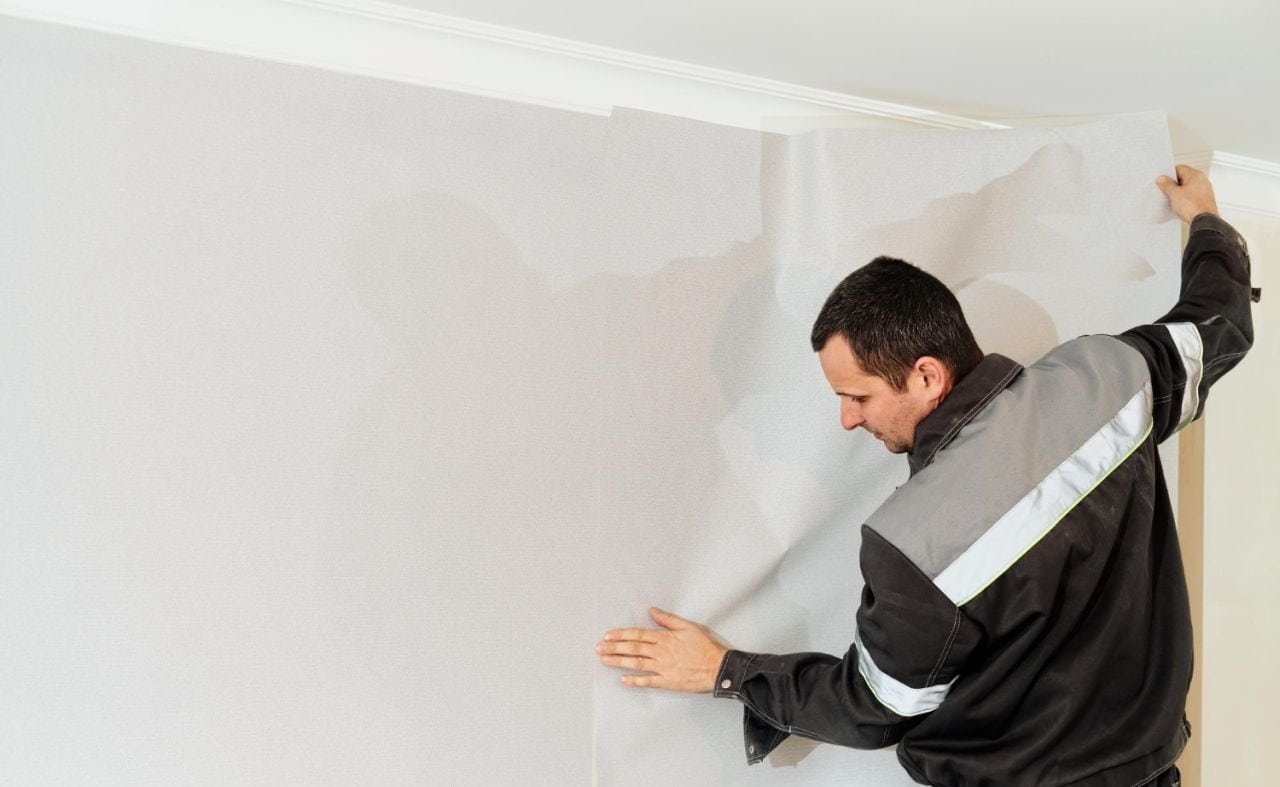Plastering is applying a thin coat of mortar to surfaces like brick, concrete, or composite metal.
It provides protection against weather elements, creates a smooth base for paint, and hides imperfections, making walls more durable and aesthetically pleasing.
Several factors, from surface preparation to curing, must be considered to ensure the highest quality of your plastered wall.
Let’s get straight to the point.
To assess plaster quality on walls, focus on proper surface preparation, ensuring cleanliness, roughness, and evenness. Key quality checks include looking for cracks, adhesion, hollow sounds, moisture levels, and uniform colour.
Common plaster issues like cracking, bulging, mould, and poor adhesion usually result from incorrect techniques.
Following best practices—like using the right mix ratios, curing, and even application—can enhance durability.
Hiring a professional plasterer ensures expertise, problem detection, safety, and long-term cost savings by delivering a high-quality, durable finish.
Surface Preparation For Plastering

Proper preparation is key to ensuring a durable plaster finish. Here are some steps to follow:
- Clean the Surface: Ensure the wall is free from dust, dirt, and debris. Use water, a wire brush, or scraping tools to clean the surface.
A clean surface helps the plaster adhere better.
- Create Roughness: The surface should be slightly rough to improve adhesion, especially on brick walls. This can be done by raking or using plain grout.
Sprinkling water on the surface can also aid in better bonding.
- Ensure Surface Evenness: Any uneven surfaces can cause problems later. An even surface allows for a smoother and more consistent plaster application.
Checking For Quality Issues In Plastered Walls
Inspecting the quality of plaster on a wall is essential to ensure it meets the required standards. Here are the key checks you should perform to identify potential issues:
1. Cracks
- Where to Check: Examine the edges, corners, and joints, as these areas are more prone to cracking.
- Common Causes: Cracks often result from improper application techniques, insufficient curing, or structural movement.
- How to Fix: Minor cracks can be patched with fresh plaster; larger ones may require professional intervention to address underlying issues.
2. Uneven Surfaces
- Inspection Tip: Shine a yellow halogen light at an angle to the wall to highlight bumps and surface imperfections.
- Problems: Uneven surfaces suggest poor application and can make the wall look unprofessional.
- Correction: Sand down the high points and reapply a thin coat of plaster if necessary.
3. Adhesion
- Test Method: Gently scrape the surface with a tool or your fingernail.
- Indicators of Poor Adhesion: The adhesion is weak if the plaster easily flakes or powders.
- Solution: Reinforce the surface with a bonding agent before reapplying the plaster.
4. Tap Test
- How to Conduct: Lightly tap the plastered wall with a hammer.
- What to Listen For: Hollow sounds indicate that the plaster hasn’t properly bonded to the surface.
- Action Required: Hollow areas may need to be removed and replastered.
5. Moisture Levels
- Equipment Needed: Use a moisture meter to check for dampness within the plaster.
- Potential Issues: High moisture levels can lead to mould growth, indicating problems with the plaster mix or curing process.
- Preventative Step: Ensure proper curing by keeping the plaster moist for at least seven days.
6. Uniform Colour
- Visual Check: Look for consistency in the plaster’s colour across the wall.
- What Variations Mean: Discolouration suggests uneven application or an improperly mixed plaster batch.
- Fix: Apply a uniform skim coat to even out the colour.
Additional Quality Checks
- Surface Smoothness: Run your hand gently over the wall to feel for any rough patches that might not be visible.
- Check for Shrinkage: Watch for minor shrinkage cracks that can form as the plaster dries. This is often a sign of an overly dry plaster mix.
- Durability Test: Lightly scratch the wall with a key or a hard object. High-quality plaster should show marks slowly.
Performing these checks regularly will help ensure that your plastered walls remain durable and maintain a flawless finish over time.
Common Problems In Poor Plastering
If plastering techniques are not followed properly, various issues can arise, affecting the wall’s durability and appearance. Here are some common problems:
1. Cracking
Cracks appear when the plaster mix is not applied evenly or the surface needs to be adequately prepared. These cracks can allow moisture to seep in, causing further damage.
2. Bulging Or Uneven Surfaces
This occurs if the wall is properly levelled or the plaster mix is thick in some areas. Fixing these issues might require removing the affected plaster and reapplying it.
3. Mould And Moisture
Inadequate drying times can trap moisture in the wall, leading to mould growth, especially in humid areas like kitchens and bathrooms. This can also cause health issues.
4. Lack Of Adhesion
Poor surface preparation or incorrect plaster mix can result in weak adhesion, causing the plaster to peel or flake over time.
5. Poor Aesthetic Appearance
Visible defects, such as bumps or rough patches, can make the wall unattractive and require additional work to smooth out.
Importance Of Plastering Techniques
Applying plaster correctly involves using the right materials and following a standard procedure. Here are some essential points to consider:
- Two Coats of Plaster: Typically, two coats are applied. The first coat is the rough layer, followed by a finish coat that provides the smooth, final surface.
- Mixing Ratios: The mortar mix ratio for ceilings should be 1:4 (cement to sand), while for walls, it should be 1:6. This ensures that the plaster is strong and durable.
- Curing the Plaster: Curing is essential for achieving strength and density. Spraying water or using damp gunny bags to keep the plastered surface moist for at least seven days is recommended.
Tips For Achieving A High-Quality Plaster Finish
To achieve a smooth, durable plaster finish, follow these best practices:
- Proper Surface Preparation: Clean and roughen the wall for better adhesion.
- Use Correct Mix Ratios: Stick to the recommended ratios for ceilings and walls.
- Even Application: Apply the plaster uniformly in two coats, allowing the first coat to set before applying the finish layer.
- Allow Proper Curing Time: Maintain moisture for at least seven days to ensure the plaster sets properly.
The Importance Of Hiring A Professional Plasterer

Engaging a skilled plasterer ensures that the job is done right the first time. Here are some reasons to consider hiring a professional:
1. Expertise And Efficiency
A professional has the skills to prepare the surface, mix the plaster correctly, and apply it evenly, saving you time and money in the long run.
2. Problem Detection
Experienced plasterers can identify potential issues early and advise on the best solutions, preventing costly repairs later.
3. Safety Standards
Plastering can be hazardous. Professionals use the correct safety gear and follow strict safety protocols to avoid accidents.
4. Warranty And Insurance
Reliable plasterers offer warranties on their work, ensuring that any future issues are dealt with at no extra cost. They are also insured, protecting you from liability in case of mishaps.
5. Reputation And Reliability
Professionals have a proven track record of delivering high-quality results backed by positive customer reviews and recommendations.
Conclusion
High-quality plastering is crucial for creating durable, smooth, attractive wall finishes.
From the initial preparation to the final coat, each step must be followed precisely to avoid common problems like cracks, mould, or poor adhesion.
For the best results, consider hiring a professional plasterer who can ensure the job is completed to the highest standard.
This investment can save time and money by preventing issues arising from poorly executed plasterwork.
Frequently Asked Questions About Plaster
Which type of plastering is best?
Exterior walls are best plastered with cement plaster due to its resistance to moisture, which helps to shield the wall from the effects of climate change and pollution. In addition, cement plaster’s durability makes it a great option for both exterior and interior applications.
How many layers of plaster should be used?
In order to achieve a professional-looking sheen, you’ll need to apply at least two coats. After the second coat has dried, check for obvious grooves and indents; if there are any, trowel on a third.
What are the defects in plastering?
Plastering work often has issues like blistering, cracking, efflorescence, flaking, peeling, popping, softness, and uneven surfaces. As soon as these plastering flaws are spotted, they must be fixed.
What is the ideal temperature for plastering?
Ventilation, temperature, and humidity levels must all be taken into account to guarantee productive work environments. Plaster should be applied in temperatures between 60 and 70 degrees Fahrenheit (at least 55 degrees Fahrenheit) and relative humidities that correspond to normal drying conditions.
How can plastering defects be prevented?
Preventative measures include selecting appropriate materials and following standard construction procedures, as well as proper preparation and cleaning of the wall surface. Plasterwork is less likely to delaminate when the wall surface is clean and properly prepared for the application of the plaster.

